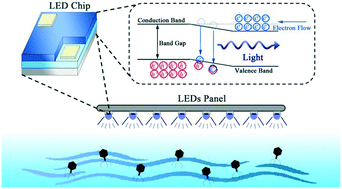LED revolution: fundamentals and prospects for UV disinfection applications†
Abstract
The UV-light emitting diode (LED) has been attracting significant attention as a new UV source that can replace conventional mercury gas-filled lamps in water disinfection applications. However, the UV-LED remains a relatively new addition to the water treatment toolbox. The current lack of fundamental understanding risks underutilizing uniquely advantageous features of the UV-LED due to unguided design and non-optimized disinfection practices. Our review presents the necessary fundamental knowledge required for the successful implementation of UV-LEDs, including the mechanism of light generation, LED chip fabrication, package design, and essential properties of UV-LEDs. We introduce distinct advantages, such as wavelength tuning, control of radiation patterns, and array design, while emphasizing the significant differences between LED and mercury lamp technologies required to achieve successful technology transfer. Previous studies investigated the design of UV-LED disinfection systems; however, little consensus has yet emerged regarding the integration of LEDs into flow-through reactors. While UV-LED disinfection systems will undisputedly mature in the near future, environmental engineers face a number of urgent research needs in this area including heat sink design, radiation pattern and array design optimization for uniform UV dose delivery, targeted pathogen-wavelength considerations, improved light extraction, and component monitoring systems.

- This article is part of the themed collections: Environmental Science: Water Research & Technology: Editors' Choice and Environmental Science: Water Research & Technology 2017 Most Downloaded Articles


 Please wait while we load your content...
Please wait while we load your content...